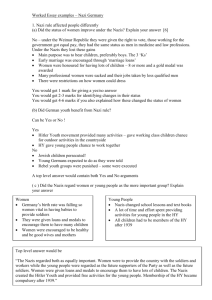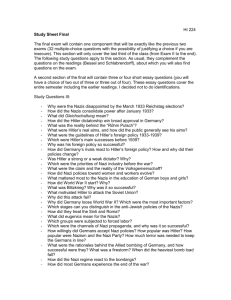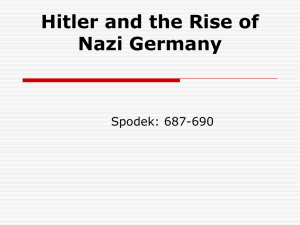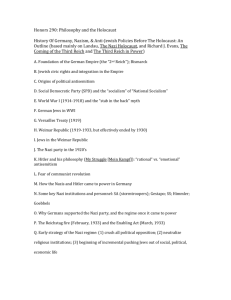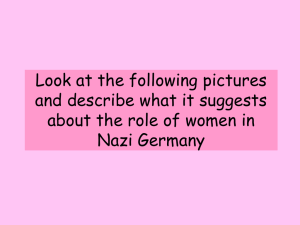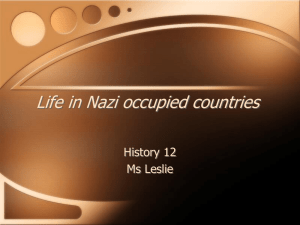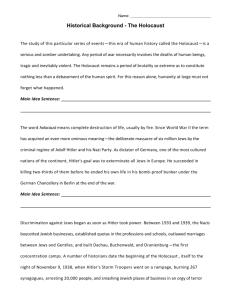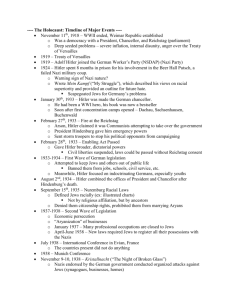Key Terms Life in Nazi Germany
advertisement
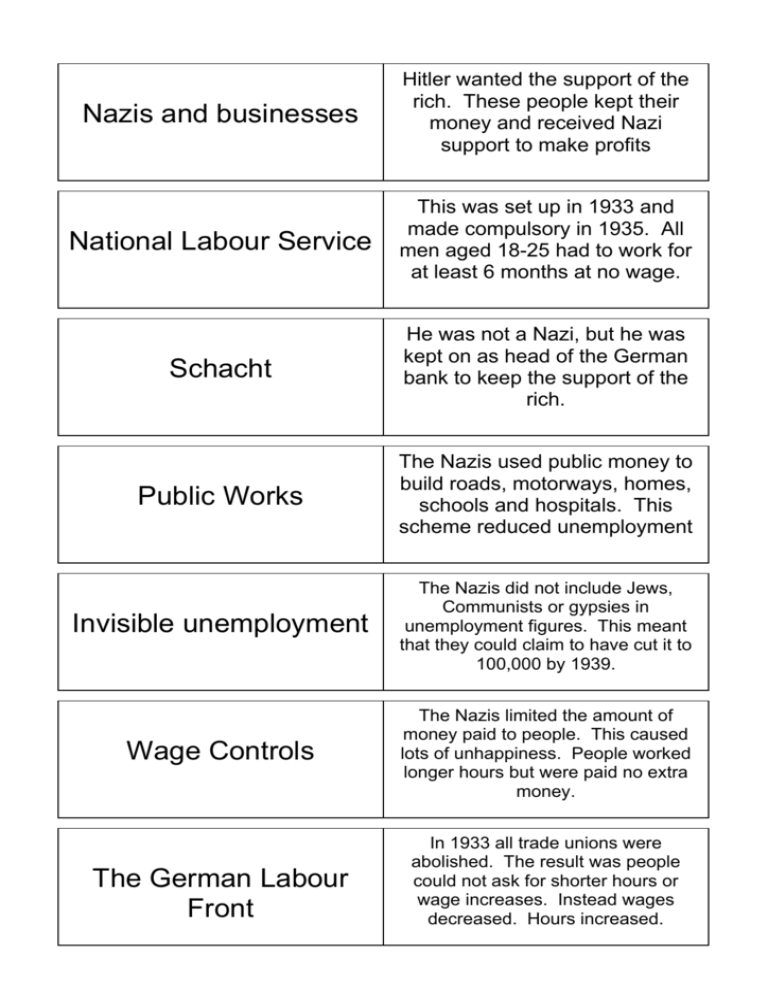
Nazis and businesses Hitler wanted the support of the rich. These people kept their money and received Nazi support to make profits National Labour Service This was set up in 1933 and made compulsory in 1935. All men aged 18-25 had to work for at least 6 months at no wage. Schacht He was not a Nazi, but he was kept on as head of the German bank to keep the support of the rich. Public Works The Nazis used public money to build roads, motorways, homes, schools and hospitals. This scheme reduced unemployment Invisible unemployment The Nazis did not include Jews, Communists or gypsies in unemployment figures. This meant that they could claim to have cut it to 100,000 by 1939. Wage Controls The Nazis limited the amount of money paid to people. This caused lots of unhappiness. People worked longer hours but were paid no extra money. The German Labour Front In 1933 all trade unions were abolished. The result was people could not ask for shorter hours or wage increases. Instead wages decreased. Hours increased. Beauty of Labour Strength Through Joy A nazi organisation that was set up to improve working conditions. Nothing was actually achieved. It was a a successful propaganda exercise though. This was a system where the hardest workers were given free holidays; cheap leisure activities. This was a successful propaganda exercise. Self-sufficiency Schacht introduced a system where Germany would be able to produce enough food to feed its people. By achieving this the German people would not have to pay for expensive foreign food or goods. It cut unemployment as well Increase in Agriculture The Nazis gave farmers more money to help introduce selfsufficiency. It made many people who had suffered from WW1 and depression a new hope. Re-armament This gave employment to many. The introduction of conscription increased the army to 1.4 million and cut unemployment. Goring’s Four Year Plan This was a plan to get Germany ready for war. It was introduced in 1936. It was the most important policy in Germany and it stopped Schacht from introducing successful economic policies. Volkgemeinschaft This was a policy to control the lives of ordinary Germans. It defined the roles of women and children 3 K’s Women in Nazi Germany Motherhood in Germany Sterilisation Contraception These were Kinder,Kirche and Kuche (Children, Church and Cooking) These were the policies for women Laws were passed stopping them from professional jobs. Employers were persuaded not to employ them. 1) Interest free loans were given to women who gave up work to have children 2) The motherhood Cross system gave medals to women depending on the number of children that they had had. 3) Marriage Loans Men and women who were seen as unfit were sterilised against their wishes. All contraception and abortions were banned in Nazi Germany Teaching All teachers had to join and pass Nazi tests. All teachers who were seen as unreliable were sacked. Others had to join the Nazis Teaching League. National Curriculum taught Aryan supremacy in biology and PE. All history books were rewritten. Hitler Youth This was an organisation to make all children loyal supporters of the Nazi Regime. All members went on camps to improve military or motherhood skills. By 1939 it was made compulsory to with the Hitler Youth Law. After this it lost support. Aryan This was the idea that the German people were a perfect race. They were a Northern European people that had “created culture” The Nazis employed scientists and historians to make up evidence to support this idea. Untermenschen These were all non-aryan races. This applied especially to Jews, Blacks, Slavs and Gypsies. They wanted to destroy culture and had to be destroyed. Ubermenschen Legal Persecution of the Jews Nuremberg Laws 1935 1936 anti-Jewish Laws Kristallnacht These were the master race. It was the Nazi plan to breed and use eugenics to create the Aryan master-race. This is another word for master-race. In 1933 Jewish shops were boycotted; Laws were passed in 1934 to ban Jewish people working in education, law and civil service. In 1934 Jews were also banned from public areas like parks and swimming pools. In 1935 the Nuremburg law was passed This removed citizenship from the Jewish people and forbade any intermarriage or relationships between Jews and non-Jews. It also restricted the rights of other non-German groups. In this years the Jews were banned from attending schools and were forbidden to own land. This occurred in November 1938. It was the night of broken glass. It happened after a Jew in France attacked a member of the SS. The SS used it as an excuse to attack all Jewish industry and homes. Goebbels encouraged the action. 20,000 Jews were arrested and put in concentration camps and 1,000’s of shops and homes were destroyed. Ghettos and Jews After the invasion of Poland Nazism needed to use another policy to deal with the Jews. They built ghettos which were deprived of food and medical supplies. Soap and water was also banned The result was the Jews became dirty and hungry. 1000’s died and the ghettoes were constantly reduced in size. Einsatzgruppen With the invasion of USSR the Nazis had another 5 million Jews to deal with. At this stage this special squad of the SS were used as extermination groups to kill Jews and place their bodies in mass graves. 100,000’s were killed this way Madagascar Plan Nazi Leadership wanted to deal with the Jewish people. They came up with this plan to change Madagascar into a huge Ghetto. All Jews would be left on the island with no escape or food. Eventually they would kill each other. Final Solution Goring and Heydrich prepared this in 1941. It was decided in 1942 at the Wansee Conference in Berlin. The idea was to set up extermination factories in Europe. Eichmann was put in charge of the project. It created the idea of a concentration camp which would process Jewish bodies for profit. Extermination Camps Part of the Final solution. These were used to process Jewish bodies for profit. Gas and ovens were used to kill and destroy the waste produced. Political Opposition Red Orchestra The Communists and the Socialists went underground after the Nazis came to power. They could not co-operate – but they did leaflet people and organise sabotage against the Nazis. This was ineffective. This group helped the Soviet Union against the Nazis. Those that were sympathetic to the Communists sent military secrets to Stalin’s army. White Rose Group This was a group of 18-25 year old students who campaigned against the Nazis. They were unfortunately rounded up and publicly executed. Swing Movement These were young people who wanted to listen to Jazz and hated being forced to join the Hitler Youth. Eidelweiss Pirates This was a working class group who used violence and sabotage against the Nazis. They often ambushed the Hitler Youth and beat them up, and one group even blew up a Nazi munitions factory. Religious Opposition Successfully fought against Hitler’s euthanasia program (Von Galen) Pastor Niemoller fought against Hitler’s control of the Protestant church by setting up a Confessing church – he was sent to a concentration camp Beck Goerdeler Group Goerdeler (Mayor of Leipzig) and Beck (chief of army) was a resistance group against eth Nazis. It was not successful. July Bomb Plot Stauffenberg was keen to return Germany to a democracy. He and his allies von Tresckow and von Witzleben tried to destroy Hitler with a bomb in a bag. It failed because Hitler was protected by a table leg. The conspirators were hanged. Impact of Allied Bombing At the end of the war many ordinary Germans turned against the Nazis. They began to see that the Nazis had destroyed their homes and threatened to destroy their lives.

